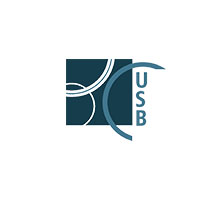Friedrich, Michel Sascha  ORCID: 0000-0003-2409-4614
(2025).
Structural and functional connectivity in patients with glioma.
PhD thesis, Universität zu Köln.
ORCID: 0000-0003-2409-4614
(2025).
Structural and functional connectivity in patients with glioma.
PhD thesis, Universität zu Köln.

|
PDF
PhD_Thesis_Friedrich_Connectivity.pdf Bereitstellung unter der CC-Lizenz: Creative Commons Attribution. Download (15MB) |
Abstract
The functional organization of the human brain is based on neuronal connections (edges) between cortical regions (nodes), known as structural connectivity. This may become disrupted by tumor growth or multimodal treatments, leading to cognitive impairment. Functional connectivity, on the other hand, is defined as the temporally correlated activity of nodes, established by some or all of the anatomical edges between them. We hypothesize that tumor- and therapy-induced lesions differentially affect white matter integrity, resulting in reduced structural connectivity and impaired cognitive performance. Furthermore, the degree of functional connectivity between tumor-infiltrated brain regions and affected brain networks should be associated with overall survival. In a cohort of 121 patients with recurrent glioma, the integrity of the white matter in various cortical lesions was initially assessed. For this purpose, the local neuronal fiber density was determined using state-of-the-art tractography methods. The underlying tractographies were then used together with the results of a cognitive performance test battery to establish a relationship between cognition and brain connectivity using a machine learning approach. To investigate resting-state functional connectivity between metabolically active glioma regions and brain networks, a correlation analysis was performed in a subset of 82 patients. The significantly impaired integrity of the white matter due to edema and gliosis had a similar negative impact on the performance status of the patients as that of the contrast- enhancing tumor parts. Reduced structural connectivity between resting-state networks was identified as a critical factor in cognitive performance, with the majority of affected nodes located in the left hemisphere. Additionally, resting-state functional connectivity to these networks was preserved in the metabolically active glioma region, with connectivity to specific networks associated with improved overall survival. In order to maintain the overall performance of glioma patients and reduce cognitive decline, treatment planning should adopt a more network-based approach, taking into account the influence of edema and gliosis. Additionally, a great clinical potential for prognostication lies in the functional connectivity between the glioma region and the surrounding brain tissue.
| Item Type: | Thesis (PhD thesis) |
| Translated title: | Title Language Strukturelle und funktionelle Konnektivität bei Patienten mit Gliom German |
| Translated abstract: | Abstract Language Die funktionelle Organisation des menschlichen Gehirns basiert auf neuronalen Verbindungen (Kanten) zwischen kortikalen Regionen (Knoten), bekannt als strukturelle Konnektivität. Diese kann durch Tumorwachstum oder multimodale Behandlungen gestört werden, was zu kognitiven Beeinträchtigungen führen kann. Die funktionelle Konnektivität hingegen ist definiert als die zeitlich korrelierte Aktivität von Knoten, die durch mehrere oder alle anatomischen Kanten zwischen ihnen etabliert wird. Wir stellen die Hypothese auf, dass tumor- und therapiebedingte Läsionen die Integrität der weißen Substanz unterschiedlich beeinträchtigen, was zu einer reduzierten strukturellen Konnektivität und verminderter kognitiver Leistung führt. Darüber hinaus sollte der Grad der funktionellen Konnektivität zwischen tumorinfiltrierten Hirnregionen und betroffenen Hirnnetzwerken mit dem Gesamtüberleben assoziiert sein.
In 121 vorbehandelten Patienten mit rezidivierendem Gliom wurde zunächst die Integrität der weißen Substanz in verschiedenen kortikalen Läsionsgebieten untersucht. Dazu wurde die lokale neuronale Faserdichte mittels modernster Traktografieverfahren bestimmt. Die zugrundeliegenden Traktografien wurden dann zusammen mit den Ergebnissen einer Testbatterie zur kognitiven Leistungsfähigkeit verwendet, um mittels maschinellen Lernens einen Zusammenhang zwischen Kognition und Hirnkonnektivität herzustellen. Für die Untersuchung der funktionellen Konnektivität im Ruhezustand zwischen metabolisch aktiven Gliom-Regionen und Gehirnnetzwerken wurde eine Korrelationsanalyse in einer Untergruppe von 82 Patienten durchgeführt.
Die durch Ödeme und Gliose deutlich beeinträchtigte Integrität der weißen Substanz hatte einen ähnlichen negativen Einfluss auf den Leistungsstatus der Patienten wie die der kontrastmittel-aufnehmenden Gliomanteile. Die verringerte strukturelle Konnektivität zwischen Ruhezustandsnetzwerken erwies sich als kritischer Faktor für die kognitive Leistungsfähigkeit, wobei die Mehrzahl der betroffenen Knoten in der linken Hemisphäre lagen. Zudem blieb die funktionelle Konnektivität im Ruhezustand zu diesen Netzwerken innerhalb der metabolisch aktiven Gliom-Region erhalten, wobei die Konnektivität zu bestimmten Netzwerken mit einem besseren Gesamtüberleben assoziiert war.
Um die Leistungsfähigkeit von Patienten mit Gliomen zu bewahren und den kognitiven Abbau zu verringern, sollte die Behandlungsplanung einen eher netzwerkbasierten Ansatz verfolgen, wobei der Einfluss von Ödemen und Gliose zu berücksichtigen ist. Darüber hinaus liegt ein großes klinisches Potenzial für die Prognose in der funktionellen Konnektivität zwischen der Gliom-Region und dem umgebenden Hirngewebe. German |
| Creators: | Creators Email ORCID ORCID Put Code |
| URN: | urn:nbn:de:hbz:38-786671 |
| Date: | 2025 |
| Language: | English |
| Faculty: | Faculty of Medicine |
| Divisions: | Außeruniversitäre Forschungseinrichtungen > Forschungszentrum Jülich |
| Subjects: | Natural sciences and mathematics Life sciences Medical sciences Medicine |
| Uncontrolled Keywords: | Keywords Language structural connectivity English functional connectivity English glioma English |
| Date of oral exam: | 1 July 2025 |
| Referee: | Name Academic Title Weiss-Blankenhorn, Peter Univ.-Prof. Dr. med. van Eimeren, Thilo Univ.-Prof. Dr. med. |
| Refereed: | Yes |
| URI: | http://kups.ub.uni-koeln.de/id/eprint/78667 |
Downloads
Downloads per month over past year
Export
Actions (login required)
 |
View Item |

 https://orcid.org/0000-0003-2409-4614
https://orcid.org/0000-0003-2409-4614